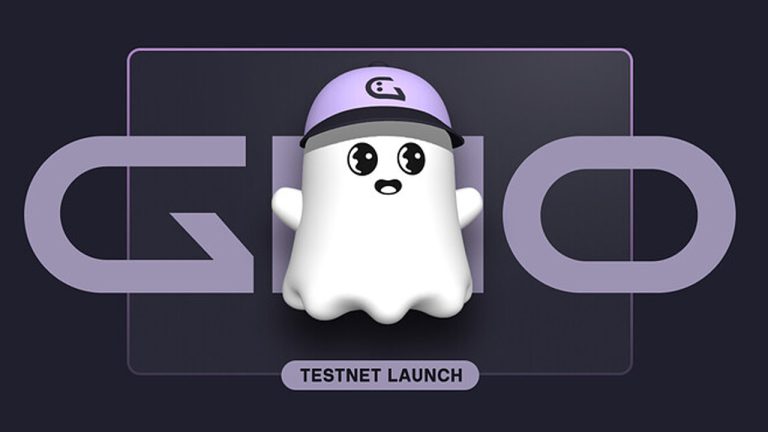 Stacks has initiated the rollout of its Nakamoto upgrade introducing improvements to its Bitcoin layer two (L2) solution. The upgrade aims to bolster transaction speed and security, potentially revitalizing interest in Bitcoin’s extended capabilities. Stacks Initiates Nakamoto Upgrade, Targets Enhanced Bitcoin Scalability Stacks, an L2 protocol addressing Bitcoin’s scalability challenges and expanding its blockchain functionalities, […]
Stacks has initiated the rollout of its Nakamoto upgrade introducing improvements to its Bitcoin layer two (L2) solution. The upgrade aims to bolster transaction speed and security, potentially revitalizing interest in Bitcoin’s extended capabilities. Stacks Initiates Nakamoto Upgrade, Targets Enhanced Bitcoin Scalability Stacks, an L2 protocol addressing Bitcoin’s scalability challenges and expanding its blockchain functionalities, […] The layer two (L2) project Stacks has officially released its public Nakamoto Testnet, offering a refined testing ground for developers and signers ahead of the mainnet launch. Stacks Introduces Nakamoto Testnet for Comprehensive Pre-Mainnet Testing In a significant step forward for the Stacks ecosystem, the Nakamoto Testnet has been introduced, providing a formal and public […]
The layer two (L2) project Stacks has officially released its public Nakamoto Testnet, offering a refined testing ground for developers and signers ahead of the mainnet launch. Stacks Introduces Nakamoto Testnet for Comprehensive Pre-Mainnet Testing In a significant step forward for the Stacks ecosystem, the Nakamoto Testnet has been introduced, providing a formal and public […]
The firm behind the second-largest dollar-pegged crypto asset by market cap is launching a new token standard for their stablecoin. According to a new announcement, Circle is introducing the Bridged USDC Standard, a new standard and process for deploying a bridged form of USDC on Ethereum Virtual Machine (EVM) blockchains. Circle says that the bridged USDC […]
The post Circle Launches New ‘Bridged USDC Standard’ To Reduce Fragmentation Across Chains appeared first on The Daily Hodl.

Binance’s Ethereum layer-2 scaling platform, opBNB, is now publicly available, following extensive testing of the OP Stack-based platform.
The BNB Chain blockchain ecosystem is set to tap into Optimism’s rollup technology, powering its newly launched opBNB layer-2 scaling platform.
BNB Chain announced the public mainnet launch of its Ethereum Virtual Machine (EVM)-compatible L2, which delivers lower gas fees and faster transactions to decentralized applications running within the ecosystem.
The opBNB platform reportedly handled over 35 million on-chain transactions and saw more than 150 decentralized applications (DApps) deployed on its testnet. BNB Smart Chain also claims that the platform achieved a peak of 4,000 transactions per second during a stress test of its capabilities.
Related: Can the Optimism blockchain win the battle of the rollups?
BNB Chain senior solution architect Arno Bauer highlighted scalability and security as top priorities for the scaling solution while meeting stringent criteria:
“This included high availability, 4K transactions per second, rigorous stress testing, reduced gas costs under 0.2 gwei, fast finality under 1 second and enhanced security with multiple external audits.”
As Cointelegraph previously reported, opBNB is based on the Optimism OP Stack and is EVM-compatible, allowing it to interact with Ethereum-based smart contracts, networks and ERC-20 token standards.
This solution makes use of optimistic rollups to scale transactions by assuming that transaction data proven off-chain is valid until proven otherwise. The technology has been important in helping the Ethereum network scale, but critics highlight the week-long lockup of funds in these protocols, while validation checks are processed.
Optimism has seen significant growth in daily transaction volumes processed and an increasing number of active daily addresses, suggesting that the layer-2 solution continues to offer value to users and DApps.
A number of major decentralized finance (DeFi) protocols have also deployed on Optimism to harness its scaling capabilities. This includes the likes of Uniswap, Aave, 1inch Network, SushiSwap and Curve Finance.
Cointelegraph has reached out to BNB Chain to ascertain further details of opBNB’s development and other scaling solutions that may have been considered by the ecosystem.
Magazine: Recursive inscriptions: Bitcoin ‘supercomputer’ and BTC DeFi coming soon

Manta Network has launched its zero-knowledge proof layer 2 scaling network which promises lower fees and higher throughput for developers looking to deploy decentralized applications.
The ecosystem of layer 2 blockchain solutions powered by zero-knowledge proofs welcomes a new player as Manta Network takes its ZK-as-a-service platform live.
Manta Pacific is a modular L2 aimed at powering EVM-native decentralized applications (DApps) using ZK-proof technology. The platform offers a software development kit and ZK library that is touted to provide plug-and-play functionality for developers.
Being EVM-native means that apps deployed on Ethereum can be deployed on Manta Pacific and vice versa, while being ZK-enabled provides low gas fees and scalability. Users can also bridge Ethereum to Manta to begin exploring its development environment.
Related: Manta Network developer raises $25M in Series A, launches layer 2 for ZK apps
With industry peers including the likes of Consensys’ Linea zkEVM, Polygon zkEVM, Starknet, Coinbase’s Base and zkSync Era, there are a number of ZK-proof L2 solution options available to Web3 developers.
Speaking to Cointelegraph following the mainnet launch, Manta Network core contributor Kenny Li said that the different ZK-rollip L2s offer different value propositions that aim to solve significant problems being faced by developers.
“We think that in the mid to long term, the market will converge to a small number of available solutions that are focused on making it as easy as possible for developers to build and deploy ZK-enabled applications.”
Li added that the Web2 world of technology followed a similar evolution with the success of software-as-a-service models where a plug-and-play approach was taken:
“This is crucial when zero knowledge is involved whereby developers do not have to worry about the infrastructure as the complexity of cryptography can be abstracted away.”
According to the Manta Network core contributor, Manta Pacific has been in development for nine months while its testnet launch in July 2023 has seen the creation of 150,000 wallets and over 3.5 million transactions.
Manta raised $25 million from investors in July 2023 aimed at scaling the project’s network and use cases with an eye on driving adoption in the Asian market.
Magazine: Here’s how Ethereum’s ZK-rollups can become interoperable

ARB’s price slumps to a new low as a decline in TVL, a decline in active addresses engaging with its DApps and a general malaise across the crypto market take their toll.
Arbitrum has emerged as a leading contender within the Ethereum network’s layer-2 scalability solutions, boasting a significant total value locked (TVL) and notable activity. However, between Sept. 9 and Sept. 11, the price of Arbitrum (ARB) tokens experienced a sharp decline of 14.5%, marking its lowest point in history.
Investors are now eagerly seeking insight into the factors driving this movement and questioning whether Arbitrum still possesses the competitive edge, especially considering that irrespective of the ARB token performance, the network TVL exceeds $1.6 billion.

It is worth noting that the past week has been challenging for most cryptocurrencies, but among Ethereum’s scaling solutions, none experienced a drop exceeding 9%, except for Arbitrum.
One potential source of concern stems from the absence of any instances of fraud proof issuance since the launch of the Arbitrum mainnet in August 2021. Offchain Labs confirmed this information to Cointelegraph on Sept. 4. Developers, however, have explained that this situation aligns with the intended operation of the system, as validators with malicious intentions risk losing their entire stake. Consequently, this data is unlikely to have significantly impacted the price in the past week.
Additional factors that may help elucidate the recent price downturn are associated with governance proposals from Arbitrum's decentralized autonomous organization (DAO). The first proposal, posted on Sept. 2, aims to allocate up to 75 million ARB tokens from the project’s treasury to address “short-term community needs” for active decentralized applications (DApps) within the ecosystem. However, even if approved, this allocation represents less than 2% of the DAO treasury holdings and is unlikely to have triggered the ARB token price correction, regardless of one’s stance on the proposal.
Another governance proposal that has garnered attention was introduced on Sept. 9 by PlutusDAO. This proposal seeks to return tokens from the DAO treasury to ARB holders through the activation of a staking mechanism, creating a native yield for participants, which could involve up to 2% of the total supply annually. Nevertheless, some investors view this inflationary approach as unnecessary and argue that it only exerts downward pressure on prices.
im not a VC so i'd "benefit" from this but..
— PSY (@PSYTWEAK) September 10, 2023
dilution through inflation would be a PVP proposal, instead of trying to bring more value into the ecosystem it extracts it from other ARB holders
Arbitrum is in a good position all round, one of the most popular chains, huge… https://t.co/IDpcdQfQHT
As user Psy highlighted on the X (formerly Twitter) social network, “dilution through inflation” does not contribute positively to the ecosystem, as it merely distributes DAO treasury holdings.
Beyond token governance, there are also concerns related to liquidation risks on both centralized and decentralized exchanges that offer leveraged trading. For instance, Lookonchain has observed a whale withdrawing ARB tokens from the Aave lending platform and transferring some to Binance.
A whale who is long $ARB on #Aave is selling $ARB to repay the debt.
— Lookonchain (@lookonchain) September 11, 2023
Over the past 5 hours, the whale has withdrawn 5M $ARB ($3.85M) from #Aave and deposited 3.8M $ARB ($2.93M) to #Binance.
And the whale currently holds 8M $ARB ($6.16M).https://t.co/HpuZnHbap4 pic.twitter.com/qduKeWC4ul
The challenge with this analysis lies in the ambiguity of cause and effect. Typically, leverage long positions are compelled to close when token prices have already fallen, rather than the reverse. This underscores the importance of investors examining Arbitrum’s activity and deposit trends over the past couple of months, which could have potentially triggered the recent price performance.
Arbitrum's TVL has notably declined to $1.67 billion, marking its lowest level since mid-February.

This 25% decrease over the past two months raises several concerns, primarily indicating a loss of investor confidence. This downturn has the potential to reduce liquidity and undermine the project’s overall viability. Furthermore, it might deter new participants, impeding network growth and adoption.
Next, it's crucial to examine the number of active addresses within the network's top DApps.

There is a noticeable decline in 30-day active addresses, even among well-established DApps like Uniswap, 1inch, Radiant, SushiSwap and GMX. Therefore, when considering the decrease in TVL alongside reduced user activity, it becomes evident that there is a substantial decline in demand for the network. While pinpointing a singular cause for this movement is challenging, one can speculate that competing chains such as zkSync Era and Coinbase’s Base may have contributed.
The data suggests that Arbitrum’s 14.5% correction appears to result from a combination of investor dissatisfaction with the governance mechanism and the network’s lackluster activity, despite offering significantly lower fees compared to Ethereum. Unless there is an upswing in transactions and an expansion of its user base, it is unlikely that ARB will be able to close the price performance gap with its competitors.
This article is for general information purposes and is not intended to be and should not be taken as legal or investment advice. The views, thoughts, and opinions expressed here are the author’s alone and do not necessarily reflect or represent the views and opinions of Cointelegraph.

The total supply of the SUI token is capped at 10 billion coins, with tokens running on a delegated proof-of-stake consensus algorithm.
Major cryptocurrency exchanges around the world are launching trading of the Sui (SUI) token amid the Sui Network’s mainnet launch on May 3.
According to an official announcement by the Sui Foundation, the Sui mainnet went live at 12:00 pm UTC. Many global crypto trading platforms supported the Sui mainnet launch, enabling investors to buy and sell the new SUI token.
Crypto exchange Binance plans to debut SUI trading immediately after mainnet launch. The platform will allow users to trade between SUI and cryptocurrencies like Bitcoin (BTC), Tether (USDT) and BNB (BNB) at 12:15 pm UTC. The firm will also enable investors to exchange SUI against euros and Turkish liras.
Other big exchanges, including Huobi, KuCoin, ByBit, OKX and Poloniex, also announced SUI listings. KuCoin noted that it also plans to list SUI/USDT-margined futures and isolated margin trading pair SUI/USDT when its “liquidity meets the requirement.”
Poloniex also emphasized that the total supply of SUI is capped at 10 billion tokens.
Some South Korean exchanges, known to face investigations by local authorities for listing certain native coins, have joined the global SUI hype. Upbit is one of those exchanges preparing to start SUI trading on May 3.
Shortly after the trading launch, the value of the SUI took a sharp dive to below $2. According to data from CoingGecko, SUI tanked 40% from its opening price. In the meantime, data from CoinMarketCap and Binance suggest that SUI dropped as much as 70%. The SUI token lost the majority of value in the first five minutes after the launch of trading.

At the time of writing, the token is trading at $1.29. SUI’s fully diluted market capitalization amounts to about $13 billion.
Sui, or the Sui Network, is a layer-1 blockchain and smart contract platform designed to increase Web3 adoption with fast speeds and high scalability.
Unlike Bitcoin or Ethereum blockchains — which run on proof-of-work and proof-of-stake consensus mechanisms, respectively — the Sui platform relies on delegated proof-of-stake. That means that SUI network users can elect and vote for delegates to confirm the next block.
Related: Justin Sun issues apology after Sui LaunchPool clashes with Binance CEO
The Sui project is famous for being built on Move, a new Rust-based programming language designed at Meta, formerly known as Facebook. Sui is backed by Mysten Labs, a Web3 infrastructure organization founded by former senior executives at Meta’s Novi Research.
After Meta shut down its crypto project Diem in 2022, Mysten Labs started actively working on the Sui network. In September 2022, the Sui Foundation announced a $300 million raise for the development of the Sui ecosystem.
Magazine: Whatever happened to EOS? Community shoots for unlikely comeback
 Aave Companies, the firm behind the decentralized finance (defi) project Aave, has announced the launch of a stablecoin called GHO on the Ethereum testnet network Goerli. The codebase is available on Github and has undergone audits by Open Zeppelin, Sigmaprime and ABDK. Aave Invites Programmers to Test GHO Before Mainnet Deployment On Thursday, Aave Companies […]
Aave Companies, the firm behind the decentralized finance (defi) project Aave, has announced the launch of a stablecoin called GHO on the Ethereum testnet network Goerli. The codebase is available on Github and has undergone audits by Open Zeppelin, Sigmaprime and ABDK. Aave Invites Programmers to Test GHO Before Mainnet Deployment On Thursday, Aave Companies […] Ethereum core developers plan to activate the “Shapella” transition through the Zhejiang public testnet on Feb. 7, 2023, according to Tim Beiko of the Ethereum Foundation. If successful, Beiko said the Sepolia testnet could follow two days later, followed by the Goerli testnet. He noted that the testnet has a faucet, block explorer, and staking […]
Ethereum core developers plan to activate the “Shapella” transition through the Zhejiang public testnet on Feb. 7, 2023, according to Tim Beiko of the Ethereum Foundation. If successful, Beiko said the Sepolia testnet could follow two days later, followed by the Goerli testnet. He noted that the testnet has a faucet, block explorer, and staking […]
The Mars Hub will launch an independent Cosmos application chain and issue MARS to users who hold the token during the two snapshots on Terra Classic.
The original Terra lending protocol, Mars Hub, announced the launch of its independent Cosmos application chain on Jan. 31, along with the issue of MARS tokens to users who hold it during the two snapshots on Terra Classic.
According to a statement on Jan. 20, the Mars Hub mainnet will go live with 16 genesis validators, including Block Pane, Chill Validation, Chorus One, Cosmology, CryptoCrew Validators, ECO Stake, among others. An additional 34 slots for permissionless validators will be available post-launch.
On January 31, Mars Hub Mainnet will go live.
— Expedition | Mars Protocol ️ (@ExpeditionMars) January 20, 2023
- $MARS Airdrop.
- Red Bank and Credit Accounts on @osmosiszone. pic.twitter.com/mfWxCsaoXo
A total of 50 million MARS tokens will be delegated to genesis validators for the launch, and returned to the community pool one month later. "This temporary delegation will help protect the network from attack by a rogue validator that could potentially accumulate a large delegation of MARS shortly after genesis and begin manipulating transactions on-chain," notes the statement.
The mainnet debut is the third and last phase of a three steps process that began with a private testnet for developers and some community members, followed by a public testnet. The first Mars outpost will follow on the Osmosis blockchain in early February 2023.
Related: BIS proposes research model to study DeFi’s integration with TradFi and its risks
MARS tokens will be made claimable by eligible addresses via an airdrop that goes live with the mainnet, unlocking 64.4 million tokens for those who held MARS during the two historical snapshots on Terra Classic. A snapshot is a file with the recording state of a blockchain at a particular time, including all existing address and transactions data.
MARS tokens distribution was determined by snapshots taken before and after the depeg of Terra Class USD (UST) - block 7544910 (May 7, 2022, ~11 a.m. EST), and block 7816580 (May 28, 2022, ~11 a.m. EST).
The tokens will be available from six months after the launch via Station, Terra's new interchain wallet. Users who held MARS on Terra Classic will also inherit governance power.
In May 2022, the collapse of Terra LUNA and its stablecoin TerraUSD (UST) had a wide impact on crypto markets, hammering token's prices of decentralized finance (DeFi) projects hosted on the Terra protocol, such as Mars Protocol.